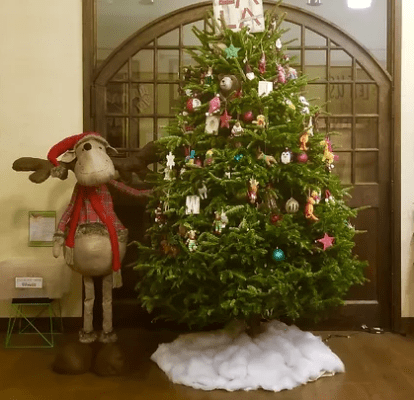‘Tis the season….for giving! During the holidays, it’s easy to get “wrapped up” in the things we will GET, but what about what we will GIVE? Giving isn’t just for adults and it isn’t just for the holidays!

The Holidays and Child Development
During the holidays, it’s easy to get caught up in the excitement, especially as a parent. In our modern world, one way we showcase our love and tradition is with presents. However, we may forget about sharing that feeling of giving with our children since they will usually be the ones receiving. Children can become overwhelmed with gifts and the excitement for the holidays. Opening presents stimulates dopamine release in the brain, leaving your child craving more. But since presents aren’t never ending, children can be disappointed after the final gift has been opened. In addition, with everyone giving children gifts and asking them what they want, children can become self-centered. During the early years of a child’s development, children are first self-focused; it takes time and developmental maturity to begin thinking of others. While the holidays are a wonderful time, they can be difficult for children that are transitioning from the “me” stage to the selfless stage.
Moreover, one of the first things that falls to the wayside during the holidays is the daily routine. Trips and family gatherings can be stressful for children, and the added layer of a different and unstable routine can be emotionally challenging. As much as you can, maintain your daily routine, especially with regards to meals.
*Tip for Working Parents: If you can only keep one routine during the holidays, don’t let the bedtime routine slip! A stable bedtime routine has the added bonus of giving you child-free nights to finish wrapping presents or spending time with loved ones once the kids are tucked in bed.
Make the Holidays Better for Kids
It’s better to give than to receive. Follow these steps to ease transitions and maintain an environment primed for cheer instead of tantrums and tears!
-
Change your focus this holiday season by involving your children in the other traditions you may have that are not focused on toys. For example, involve children in family dinners by creating a Montessori inspired cooking lesson. Children can be great helpers in the kitchen, especially with tasks such as using a rolling pin, pounding dough, stirring batter, and utilizing their Practical Life skills by pouring pre-filled measuring cups. You can use this opportunity to highlight other aspects of the holidays, like making cookies for Santa, picking out gifts for others, and creating new traditions by making time for family-centered activities like ice-skating or bowling.
-
According to the Child Mind Institute, the best way to make the holidays better for your children is to let them help out as much as you can. A Montessori philosophy can open the door to a multitude of lessons that create opportunities to connect with your children even during a busy time like the holidays. In addition, having children help out creates an opportunity for them to mirror your behavior. Not only will you pass down traditions to the next generation, but children will better see your giving spirit and will work to model that behavior as well. For example, let your child help pick out gifts for family members, create Grace and Courtesy lessons to teach your children how to set the table, and let them help you with small tasks while gift wrapping; their little fingers are perfect for holding down the knot while you tie that bow!
-
During holiday parties, remember that children can be easily overwhelmed with a different and bustling environment. Transition times can be especially difficult. Pack a bag that’s specifically designed for these stressful moments.
-
Include toys or coloring books to help children when they tire out from getting their cheeks pinched by family members.
-
Bring pajamas to simulate the bedtime routine during late-night holiday parties.
-
Structure your night to include extra time for transitions to give your children your full attention during these moments, so they can feel confident and secure with each change.
-
-
Teach children to give. While you are busy cooking, cleaning, or preparing for the holidays, set up a space where children make their own gifts for people they care about. Not only does this strengthen neural pathways for giving and thinking of others, but homemade gifts are sometimes the most cherished of them all.
-
Try Mindful gift-giving. Choose gifts that can boost a child’s self-esteem, like an art set or a train set that they can help build with you. Maria Montessori believed that the hands were a vital piece of child development, as children learn through their senses, particularly touch. You can instill long-lasting self-esteem and create opportunities for success if you consider gifts that engage children in multiple ways.

Final Thoughts
Maintaining a giving attitude all year round can help solidify selfless and altruistic behavior. Engaging in activities that bring families together doesn’t have to only happen during the holidays. For example, create a family night where you can keep the spirit of togetherness all year round!


